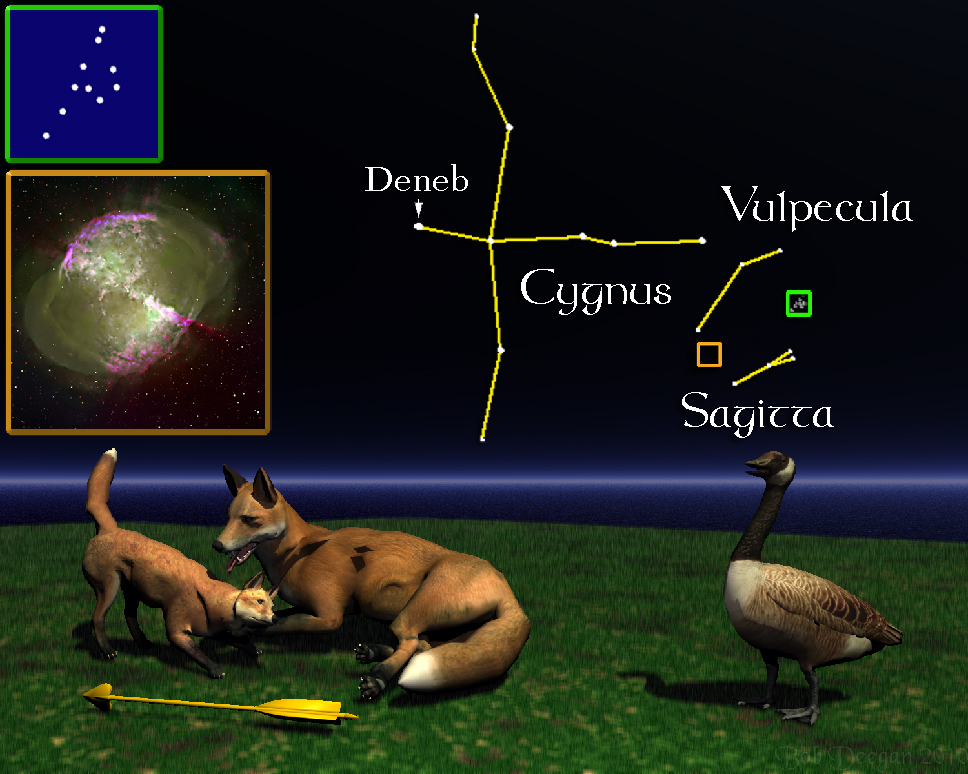
For the week including June 4, 2010

THE FOX AND ARROW
As the stars of Cygnus, the Swan, rise in the east after sunset, they bring two smaller constellations along with them. In his star atlas, published in 1690, Johannes Hevelius took some dim stars near the head of the Swan and fashioned them into the constellation of Vulpecula cum Anser, the Little Fox and Goose. Over the centuries, the Goose went its own way, leaving the Fox alone in the sky. Sagitta, the Arrow, has been listed on star charts since ancient times and is presumed to be the arrow shot by the centaur of the constellation of Sagittarius, the Archer.
Near the end of its lifetime, a star like our Sun begins to run out of nuclear fuel and undergoes a slow “death”. Its color deepens, becoming a deep and ruddy red. In a series of pulsations, it increases its size dramatically, becoming a giant. Eventually, out of fuel, the core of the star collapses and the outer layers of the star explode into space, to form a glowing nebula or cloud.One of the most famous examples of these stellar fatalities is the Dumbbell Nebula. Visible from the backyard with the help of strong binoculars or a telescope, it presents a challenging puzzle that has intrigued astronomers for years. The challenge comes from the expectations we have of objects exploding in space. In a zero gravity environment, we assume that any explosion will move outward, pretty evenly, in all directions. This would produce an expanding sphere of debris that, through a telescope, would look like a hazy bubble with a star inside. But, the Dumbbell declines to oblige us.
Shown in the National Optical Astronomy Observatory photograph at left, the Dumbbell has a remarkable helix shape that has baffled astronomers for years. Describe it as an hourglass, dumbbell, or a cosmic apple core; the double-lobe shape of this nebula is unmistakable. How is this “shaped” explosion possible?
Current thinking is that a disc of material, sloughed off of the star during its pulsation period, formed around this star’s equator. When the star exploded, the disc inhibited the explosion from moving in the disc’s direction, producing a pinched, hourglass-shaped cloud. When we view the cloud from the side, it looks like the Dumbbell.
If you want to take a look for yourself, this nebula is easily found with large binoculars by sweeping northward from the golden star that forms the point of Sagitta, the Arrow. The Dumbbell Nebula’s hazy, hourglass-shaped cloud is some 2.5 light years across and moving outward at the rate of seventeen miles per second, allowing the nebula’s age to be measured at about 48,000 years.
While you’re near the constellation of the Sagitta, look for Brocchi’s Cluster, better known as the Coat Hanger, near the Arrow’s feathers. This wonderful little cluster is visible to the naked eye and has appeared in astronomical texts as far back as the records of the Persian astronomer Al-Sufi in 964 AD. Modeled at upper left, the odd little Coat Hanger of stars always brings a smile to both amateur and professional astronomers.
Dumbbell Nebula photo credit & copyright: Michael Pierce (Indiana U.) et al., WIYN, AURA, NOAO, NSF
Unless otherwise indicated, all content of this web site is the copyright of Robert Deegan and all rights are reserved.
For more information, or to comment, please contact: Bob@NightSkies.org